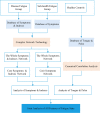Clinical data mining on network of symptom and index and correlation of tongue-pulse data in fatigue population
- PMID: 33627103
- PMCID: PMC7905588
- DOI: 10.1186/s12911-021-01410-3
Clinical data mining on network of symptom and index and correlation of tongue-pulse data in fatigue population
Abstract
Background: Fatigue is a kind of non-specific symptom, which occurs widely in sub-health and various diseases. It is closely related to people's physical and mental health. Due to the lack of objective diagnostic criteria, it is often neglected in clinical diagnosis, especially in the early stage of disease. Many clinical practices and researches have shown that tongue and pulse conditions reflect the body's overall state. Establishing an objective evaluation method for diagnosing disease fatigue and non-disease fatigue by combining clinical symptom, index, and tongue and pulse data is of great significance for clinical treatment timely and effectively.
Methods: In this study, 2632 physical examination population were divided into healthy controls, sub-health fatigue group, and disease fatigue group. Complex network technology was used to screen out core symptoms and Western medicine indexes of sub-health fatigue and disease fatigue population. Pajek software was used to construct core symptom/index network and core symptom-index combined network. Simultaneously, canonical correlation analysis was used to analyze the objective tongue and pulse data between the two groups of fatigue population and analyze the distribution of tongue and pulse data.
Results: Some similarities were found in the core symptoms of sub-health fatigue and disease fatigue population, but with different node importance. The node-importance difference indicated that the diagnostic contribution rate of the same symptom to the two groups was different. The canonical correlation coefficient of tongue and pulse data in the disease fatigue group was 0.42 (P < 0.05), on the contrast, correlation analysis of tongue and pulse in the sub-health fatigue group showed no statistical significance.
Conclusions: The complex network technology was suitable for correlation analysis of symptoms and indexes in fatigue population, and tongue and pulse data had a certain diagnostic contribution to the classification of fatigue population.
Keywords: Complex network; Fatigue; Index; Symptom; Tongue and pulse data.
Conflict of interest statement
The authors declare that they have no competing interests.
Figures











Similar articles
-
A New Approach of Fatigue Classification Based on Data of Tongue and Pulse With Machine Learning.Front Physiol. 2022 Feb 7;12:708742. doi: 10.3389/fphys.2021.708742. eCollection 2021. Front Physiol. 2022. PMID: 35197858 Free PMC article.
-
Correlation Analysis of Data of Tongue and Pulse in Patients With Disease Fatigue and Sub-health Fatigue.Inquiry. 2022 Jan-Dec;59:469580211060781. doi: 10.1177/00469580211060781. Inquiry. 2022. PMID: 35112891 Free PMC article.
-
A Study of Logistic Regression for Fatigue Classification Based on Data of Tongue and Pulse.Evid Based Complement Alternat Med. 2022 Mar 5;2022:2454678. doi: 10.1155/2022/2454678. eCollection 2022. Evid Based Complement Alternat Med. 2022. PMID: 35287309 Free PMC article.
-
Understanding fatigue in major depressive disorder and other medical disorders.Psychosomatics. 2008 May-Jun;49(3):185-90. doi: 10.1176/appi.psy.49.3.185. Psychosomatics. 2008. PMID: 18448771 Review.
-
Fatigue: Relevance and implications in the aging population.Exp Gerontol. 2015 Oct;70:78-83. doi: 10.1016/j.exger.2015.07.011. Epub 2015 Jul 17. Exp Gerontol. 2015. PMID: 26190478 Review.
Cited by
-
A New Approach of Fatigue Classification Based on Data of Tongue and Pulse With Machine Learning.Front Physiol. 2022 Feb 7;12:708742. doi: 10.3389/fphys.2021.708742. eCollection 2021. Front Physiol. 2022. PMID: 35197858 Free PMC article.
-
Efficacy of Fufang E'jiao Jiang in the Treatment of Patients with Qi and Blood Deficiency Syndrome: A Real-World Prospective Multicenter Study with a Patient Registry.Evid Based Complement Alternat Med. 2023 Feb 3;2023:3179489. doi: 10.1155/2023/3179489. eCollection 2023. Evid Based Complement Alternat Med. 2023. PMID: 36777626 Free PMC article.
-
Relationship chains of subhealth physical examination indicators: a cross-sectional study using the PLS-SEM approach.Sci Rep. 2023 Aug 22;13(1):13640. doi: 10.1038/s41598-023-39934-5. Sci Rep. 2023. PMID: 37608032 Free PMC article.
-
Deep Learning Multi-label Tongue Image Analysis and Its Application in a Population Undergoing Routine Medical Checkup.Evid Based Complement Alternat Med. 2022 Sep 29;2022:3384209. doi: 10.1155/2022/3384209. eCollection 2022. Evid Based Complement Alternat Med. 2022. PMID: 36212950 Free PMC article.
-
A New Method for Syndrome Classification of Non-Small-Cell Lung Cancer Based on Data of Tongue and Pulse with Machine Learning.Biomed Res Int. 2021 Aug 11;2021:1337558. doi: 10.1155/2021/1337558. eCollection 2021. Biomed Res Int. 2021. PMID: 34423031 Free PMC article.
References
Publication types
MeSH terms
LinkOut - more resources
Full Text Sources
Other Literature Sources
Medical

